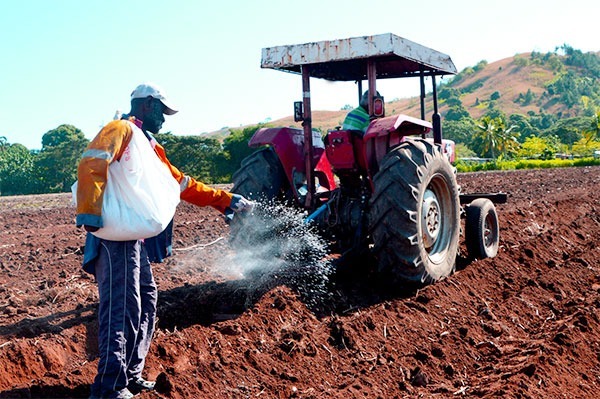The FSC is dedicated to raising awareness and educating farmers on the proper types and amounts of fertilizers to use. Additionally, FSC provides information on different varieties of cane to farmers. The FSC’s field division is responsible for delivering farm advisory and extension services to cane farmers.

CANE CULTIVATION
We have a farming calendar that is scheduled to be followed, which includes:
CANE PLANTING
Cane planting season is in two windows. The first and major is from April – May when fallow planting takes place. Land preparation should be initiated at least 0ne month before planting. Field staffs collect soil samples after the first ploughing to analyse soil fertility and health in terms of N, P, K and pH values.
CROP NUTRIENCY
-
Blend A (mostly phosphorus) should be applied at the rate of 2 – 4 bags per hectare in the drills during planting.
-
Blend B fertilizers should be applied as a top-dress application at 12 – 16 bags per hectare at the end of the germination period, around 4 – 6 after planting.
-
Blend C fertilizer should be applied on young ratoon crops.
SOIL HEALTH
-
Sugarcane grows best in soil in the range of 5.5 to 6.5 pH.
-
Where the soil is deemed acidic (below 5.5 pH), liming should be incorporated into the soil, preferably at the time of planting.
-
Depending on the clay content of the soil, it would require 1 – 2.5 tonnes per hectare of lime to improve the soil pH by 1.0 unit.
CROP PROTECTION
Crop protection plays a vital role towards the growth of the sugarcane plants. It is essential to protect the cane plants from the very beginning to be able to maximize the harvest. These will benefit both the farmers and the sugar industry. In order to help the farmers in protecting the crop, FSC has taken few steps to overcome issues such as “Disease Control”, “Fires” and “Natural Disaster “faced by the farmers.
DISEASE CONTROL
The Sugar Research Institute of Fiji conducts the monitoring and screening of sugarcane diseases in Fiji. Major diseases of sugarcane in Fiji are:
- Fiji leaf gall
- Downy mildew
- Ratoon stunting disease
FIRE
Cane burning is a contentious issue for the industry. While our field staff are at the forefront of anti-burning campaigns, every case of burning will have to be handled according to the Master Award.
CROP INFORMATION
We have been providing awareness and educating the farmers on the types of fertilizers to use and in what amount. The variety of cane is also a topic shared among the farmers. The field division of FSC is responsible for the delivery of farm advisory and extension services to cane farmers.
VITI LEVU
| SOIL TYPES | EARLY MID MATURING | MID LATE MATURING |
| Flat Fertile | Aiwa, Beqa, Naidiri LF91-1925 | Ragnar Kaba Kiuva |
| Medium | Aiwa, Beqa, Naidiri LF91-1925 | Kaba, Vatu, Kiuva |
| Poor | LF91-1925 | Kaba, Mana, Kiuva |
| Saline | Naidiri, LF91-1925 | Kaba, Mana, Galoa |
VANUA LEVU
| SOIL TYPES | EARLY MID MATURING | MID LATE MATURING |
| Flat Fertile | Kaba, Mana, Kiuva | Kaba, Mana, Kiuva |
| Medium | Kaba, Mana, Kiuva | Kaba, Mana, Kiuva |
| Poor | Naidiri, LF91-1925 | Kaba, Waya, Mali |
| Saline | Naidiri, LF91-1925 | Galoa, Vatu, Mali |
TRANSPORT
FSC have also been able to help the farmers in facilitating with the harvesting and transportation costs. FSC’s Field Division is responsible for the orderly and efficient harvest and delivery of sugarcane from the field to the mill. FSC owns and operates the entire 300km of railway infrastructure free of charge. FSC will be introducing lorries and mechanical harvesters to complement its existing fleet of vehicles. FSC launched its tractor and implements fleet. A total of thirty tractors and complementing implements was distributed to FSC field sectors nationally.


